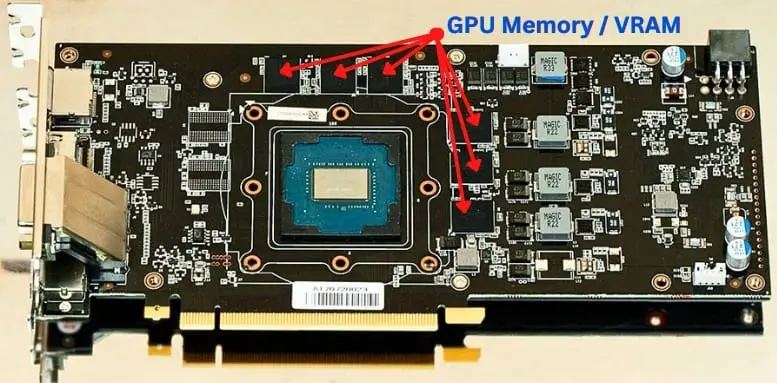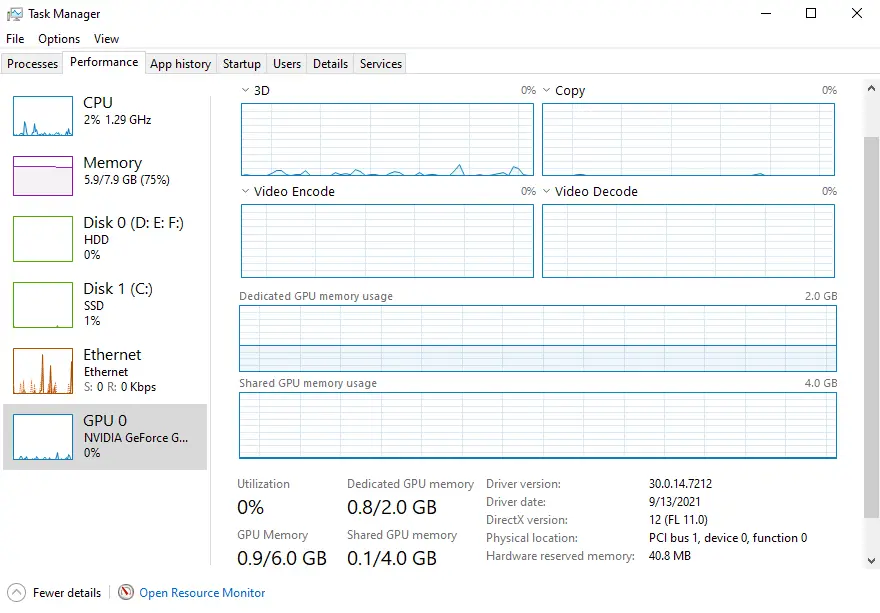Graphic cards Memory: What it does? & How much you need?
Today, I will be talking about the memory installed on Graphic cards. What is the GPU memory? Its purpose, and why the GPU RAM is even needed? Such questions and doubts have commonly have raised among PC users.
In this guide, first, I’m explaining the role of memory on graphic cards. Also, comparing it with installed RAM on the computer’s motherboard reveals the difference and other frequently asked questions on this topic.
Make sure you know that the GPU RAM is sometimes also known as video memory or VRAM, so it’s a good idea to remember it together. Let’s get started! Learning about GPU memory.
What is GPU memory? What does GPU RAM do?
The role of the GPU memory installed on a graphics board is to store graphics, images, videos, buffer loading, and textures temporarily. When doing graphic processing such as gameplay, editing and designing, it temporarily keeps video data in GPU memory as needed to perform the required processing from time to time.
In other words, You probably know that the graphic chip – for example, calculates the interaction of objects in the game is responsible for rendering any image on the computer. The intermediate data is then displayed on the monitor that is temporarily stored in the GPU RAM.
The processing speed of the graphic board is first prioritized to perform the video processing smoothly. However, if you do a lot of video processing in real-time, you may not be able to do smooth operation due to delays; this is where the shortage of GPU memory indicates.

The larger the GPU memory capacity, the more information can be stored about the graphic details, and at the same time, it can be processed. Thus, you can operate smooth, stable processes in video editing, gaming, 3d rendering, and others if you have plenty of GPU memory capacity.
The capacity of GPU memory can be considered very important, but in reality does not mean high performance. However, the graphics board’s performance itself is more important than capacity like CUDA cores, architecture. If you need a lot of GPU memory, you need a high-performance graphics board.
For example, you need a lot of GPU RAM to game at 4K resolution, but if your graphics board needs to be more powerful, you won’t be able to play at that resolution anyway. ‘You will run out of performance over GPU RAM’.
The theory is that GPU memory usage won’t be full because the performance of the graphics board will be insufficient before the lack of GPU capacity.
Not the power performance, but the 3 Significant Advantages you will have from high GPU memory:
- You can play games in high resolution,
- You can play comfortably even if you are anti-alias processing,
- High resolution 3D graphics can be processed efficiently.
What is the difference between GPU RAM (VRAM) and RAM?
This RAM is a tug of war with CPU and storage (SSD・HDD) and is completely different from the so-called VRAM (GPU RAM).
The memory on the graphics board saves only the graphics-intensive information in applications. While the system RAM, also called main memory, stores extensive information such as operating system software, applications, instructions, and other information for the CPU for direct and quick access when needed to perform tasks temporarily.
GPU RAM can reach higher speeds than traditional RAM and work on larger data buses.
For example, a standard dual channel DDR4 RAM bar works at speeds of around “3,200 MHz on a 128-bit bus”. Against a mid-range graphics card like the 6GB, GTX 1060 has GDDR5 memory that can reach speeds of up to “8,008 MHz on a 192-bit bus”.
The difference in speed is significant and can help prevent performance loss from occurring when working with larger textures or other similar elements.
Graphical memory also works together with RAM (aka shared RAM), which is why it’s sometimes called complementary memory. In addition to storing data, graphical memory is also used by the operating system to provide a resolution for your screen aspect ratio. Whenever you open an image or video, that data is retrieved from graphical memory.
To avoid doubts and help you better understand how GPU memory works, I can conclude that VRAM is to the GPU what RAM is to the CPU – a key element (Memory) that allows each one to do its job correctly.
How to check GPU memory consumption?
It is possible to check GPU RAM consumption from the task manager. Open Task Manager and click” Performance” then select “GPU” tab to see your dedicated GPU memory.

It’s easier to find out how much space you consume during gameplay or while using any other application. If you have yet to see it, you must try it.
How much GPU memory is needed for Gaming?
To enjoy current generation games, you’ll need a dedicated graphics card with GDDR5-type memory. It’s important to keep in mind that the amount of memory available doesn’t necessarily affect the power of the GPU (as mentioned above), but it can limit its performance.
For example, a GeForce GT 1030 with 2GB of memory GDDR5 at 6,000 MHz has almost the same specifications as a GT 1030 with 2GB of memory but DDR4 at 2,100 MHz; the only differences are the memory working frequency and the speed of the GPU.
The GeForce GT 1030 with GDDR5 doubles the performance of the DDR4 version, a simple and direct comparison that allows us to understand graphic memory’s value based on its speed.
The speed of memory matters but the quantity too. When we run a game, it consumes a certain amount of graphic memory depending on the settings, resolution, textures, FPS, and other factors. However, if you don’t have enough graphic memory to cover the needs of the game you may suffer undesirable effects that include:
Now, let’s know how much graphics memory you need. So, it all depends on the resolution you will play and the graphic settings. Below I have listed it as a good GPU memory size to have.
How much GPU memory do I need for Editing & 3D Rendering?
3D processing & Editing in Photoshop: 2GB RAM GPU
You can work with GTX 1650, Radeon RX 570, and GT 1030 without problems. Since these are equipped with 2GB, there is no problem. If you have Photoshop, you can handle 1GB, but I write that because 2GB is the lowest in the current model. In comparison, one can get GT 730 GDDR5 as an entry-level budget option with 2GB RAM.
Use of 3D CAD (Large scale): 8GB
Quadro P2000 or less is not enough if you deal with large 3D CAD models. Then the Quadro P4000 with 8GB will be the option. You can only work with a high-end graphics board. While GeForce Turbo GTX 1080 is a budget option with 8GB RAM.
Good to Know– If you use PC only to see multimedia content in high resolution and for office tasks, an iGPU would be enough. The Integrated GPU of the Intel UHD 600 or AMD’s Vega series with 8 GB of system RAM is sufficient for a good user experience. By cons, if you plan to play current titles, that configuration will not serve you.
Summary
GPU memory is a part that allows you to store visual information temporarily installed inside the graphics board. To show beautiful footage in real-time, it is necessary to transfer information to memory and streamline it. This differs from the memory (ROM) that stores permanently, like HDD, SSD, etc.
It is more realistic to focus on graphic card’ performance rather than considering GPU RAM. High-performance GPUs with Ti & RTX have a larger capacity of GPU memory, so you will inevitably have sufficient capacity without worrying about it.
When choosing a video card, first of all, focus on the graphics powering factors like checking memory frequency, size of the memory bus, then on the memory capacity as complementary. So you don’t have to think thoughtfully.
With this ends, the article GPU memory, ideally, has helped to understand what GPU memory is for. Its purpose and importance. Remember that you can share it on social networks so that it can help more users who need it.
